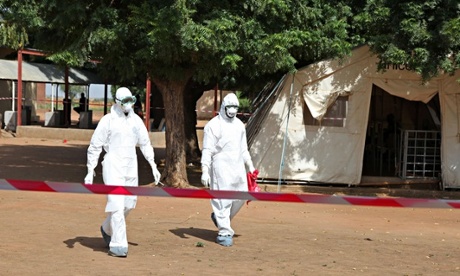
At around 10am last Wednesday, Abdouramane Koungoulba, the duty paediatrician at the Fousseyni Dao hospital in Kayes, western Mali, examined a young patient who had been brought in by a relative. The two-year-old girl, he noted, had a high fever and a nosebleed.
The relative told the doctor the girl had been born and brought up in Mali. What they did not mention was that she had just returned from neighbouring Guinea, where she had been staying with her father before he died. Nor did he reveal that she and her grandmother had made the 600-mile journey from Guinea to Kayes, via the Malian capital, Bamako, on public buses.
Later that day, the toddler’s family did tell Koungoulba about the girl’s trip across the border to Kissidougou, the Guinean town where the west African outbreak began eight months ago. “It was not until I learned she had recently been to Guinea that I took my initial suspicions seriously, that this was Mali’s first reported case of Ebola,” says the doctor, a soft-spoken man in his 30s.
Realising the enormity of the situation, Koungoulba alerted the rapid response team in the Malian capital, Bamako, and dispatched a sample of the girl’s blood for immediate testing. By Thursday evening, Mali had confirmed its first case of the virus that has killed nearly 5,000 people. A few hours later, less than two days after she was admitted, the girl died.
The authorities in Kayes moved equally swiftly. As Malians followed news of the case on television, a regional government car was speeding towards Bamako to intercept the bus that had brought the girl to Kayes before it returned to the capital.
In the early hours of Friday, about halfway between the two cities, the bus was spotted. “They literally chased down the bus, made the passengers get out, and disinfected the whole vehicle in the middle of the road,” says Shannon Strother of Unicef.
In the meantime, the job of tracing the girl’s route and working out how many people she may have come into contact with had begun. Most worrying, according to Malian health officials, was the revelation that the girl had been showing symptoms of Ebola on her bus journey. “It’s worrying, especially since she was travelling by bus,” says Dr Samba Sow from the National Centre for Disease Control (CNAM) in Bamako.
By visiting the villages and towns through which the girl and her grandmother had passed, health workers have so far identified dozens of possible contacts. “From the passenger list, where people had put down their phone numbers, we were able to identify and track all the people travelling on the bus,” says Dr Lamine Diarra at the health ministry in Bamako. However, he added, the hunt had been complicated by the fact that in parts of Mali, a whole village shares the same Sim card.
According to the World Health Organisation (WHO), 116 people in Mali are now being held under observation for the disease.
The authorities are concentrating their efforts on Kayes, a town of 128,000 inhabitants, which sits in the south-west of the country not far from the border with Senegal. To the south is Guinea, where the outbreak began this year. Given the two countries’ porous border and Kayes importance as a mining and trading region that sees workers crossing the border daily, Mali has long been seen as a potential weak point in the regional epidemic.
In Kayes – where 57 people who had contact with the girl are isolated and being monitored at the hospital or in their homes – there is anxiety and suspicion.
“They come and take our temperature twice a day,” says a woman who does not give her name for fear of the stigma associated with the disease.
Some Kayes residents wear masks; others use protective gloves. But almost everyone avoids handshakes when greeting friends and family, instead bumping elbows or moving a hand towards the heart.Last weekend, healthcare workers complained they hadn’t been trained to deal with Ebola cases.
“It’s true that some of the staff were concerned and even threatened to stop working. The problem was solved when religious leaders were called in to mediate,” says Dr Koumare Toumani, director general of the Kayes hospital.
Sow arrived in Kayes last Friday to lead the Ebola response in the region. Over the weekend health workers and volunteers were trained to trace anyone who had been in contact with the girl. “If you have one case very early on and you catch it, you’re actually lucky,” he says. “If you don’t detect that first case, you run the risk of people who are contagious staying in the community without being reported – and that’s when you run the risk of an epidemic.”
Four days after the death of the little girl, regional government officials are confident that all the people who came in contact with her have now been identified. By Tuesday a centre for diagnostics and observation built by Unicef was in place at the hospital, and screenings at the border with Senegal will be reinforced over the next days.
“It’s true we were taken by surprise by having a case here in Kayes,” says Toumani. “The structures to trace and monitor Ebola cases were not yet in place. Now, with the help of NGOs coming from Bamako, we are setting up the infrastructure to receive and isolate more patients.”
Meanwhile, in the hospital’s paediatrics department, Koungoulba thinks about his patient and Ebola protocol. “Did I really follow all the safety precautions in treating the girl?” he asks. “Did I touch her soiled nappy? Did I wipe the blood running from her nose? These are questions I ask myself over and over again.”
